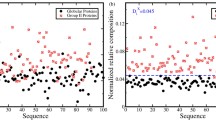Abstract
Ion pairs contribute to several functions including the activity of catalytic triads, fusion of viral membranes, stability in thermophilic proteins and solvent-protein interactions. Furthermore, they have the ability to affect the stability of protein structures and are also a part of the forces that act to hold monomers together. This paper deals with the possible ion pair combinations and networks in 25% and 90% non-redundant protein chains. Different types of ion pairs present in various secondary structural elements are analysed. The ion pairs existing between different subunits of multisubunit protein structures are also computed and the results of various analyses are presented in detail. The protein structures used in the analysis are solved using X-ray crystallography, whose resolution is better than or equal to 1.5 Å and R-factor better than or equal to 20%. This study can, therefore, be useful for analyses of many protein functions. It also provides insights into the better understanding of the architecture of protein structure.
Similar content being viewed by others
References
Balamurugan B, Samaya M K, Ramesh J, Roshan M N A, Sumathi K and Sekar K 2005 SSEP-2.0: secondary structural elements of proteins; Acta Cryst. D61 634–636
Barlow D J and Thornton J M 1983 Ion pairs in proteins; J. Mol. Biol. 168 867–885
Barril X, Aleman C, Orozco M and Luque F J 1998 Salt bridge interactions: stability of the ionic and neutral complexes in the gas phase, in solution, and in proteins; Proteins 32 67–79
Brinda K V and Vishveshwara S 2005 Oligomeric protein structure networks: insights into protein-protein interactions; BMC Bioinformatics 6 296 01–15
Fersht A R 1972 Conformational equilibria in α- and δ-chymotripsin: the energetic and importance of the salt bridge; J. Mol. Biol. 64 497–509
Hendsch Z S and Tidor B 1994 Do salt bridges stabilize proteins? A continuum electrostatic analysis; Protein Sci. 3 211–226
Hobohm U and Sander C 1994 Enlarged representative set protein structures; Protein. Sci. 3 522–524
Jayaraman S, Gantz D L and Gursky O 2006 Effects of salt on the thermal stability of human plasma high-density lipoprotein; Biochemistry 45 4620–4628
Kampmann T, Mueller D S, Mark A E, Young P R and Kobe B 2006 The role of histidine residues in low-pH-mediated viral membrane fusion; Structure 14 1481–1487
Keskin O, Ma B and Nussinov R 2005 Hot regions in protein-protein interactions: the organization and contribution of structurally conserved hot spot residues; J. Mol. Biol. 145 1281–1294
Kumar S, Ma B, Tsai C J and Nussinov R 2000 Electrostatic strengths of salt bridges in thermophilic and mesophilic glutamate dehydrogenase monomers; Proteins 38 368–383
Kumar S and Nussinov R 1999 Salt bridge stability in monomeric proteins; J. Mol. Biol. 293 1241–1255
Kumar S and Nussinov R 2000 Fluctuations between stabilizing and destabilizing electrostatic contributions of ion pairs in conformers of the c-Myc-Max leucine zipper; Proteins 41 485–497
Kumar S and Nussinov R 2001 Fluctuations in ion pairs and their stabilities in proteins; Proteins 43 433–454
Kumar S and Nussinov R 2002a Relationship between ion pair geometries and electrostatic strengths in proteins; Biophys. J. 83 1595–1612
Kumar S and Nussinov R 2002b Close-range electrostatic interactions in proteins; Chem. Biol. Chem. 3 604–617
Letai A and Fuchs E 1995 The importance of intramolecular ion pairing in intermediate filaments; Proc. Natl. Acad. Sci. USA 92 92–96
Lyu P C, Gans P J and Kallenbach N R 1992 Energetic contribution of solvent-exposed ion pairs to alpha-helix structure; J. Mol. Biol. 223 343–350
Marqusee S and Sauer R T 1994 Contributions of a hydrogen bond/salt bridge network to the stability of secondary and tertiary structure in X repressor; Protein Sci. 3 2217–2225
Mitchell J B, Thornton J M, Singh J and Price S L 1992 Towards an understanding of the arginine-apartate interaction; J. Mol. Biol. 226 251–262
Musafia B, Buchner V and Arad D 1995 Complex salt bridges in proteins: statistical analysis of structure and function; J. Mol. Biol. 254 761–770
Papaleo E, Olufsen M, De Gioia L, Brandsdal B O 2006 Optimization of electrostatics as a strategy for cold-adaptation: a case study of cold- and warm-active elastases; J. Mol. Graph. Model; Epub ahead of print
Persikov A V, Ramshaw J A M, Kirkpatrick A and Brodsky B 2005 Electrostatic interactions involving lysine make major contributions to collagen triple-helix stability; Biochemistry 44 1414–1422
Perutz M F 1970 Stereochemistry of cooperative effects in haemoglobin; Nature 228 726–739
Shanthi V, Selvarani P, Ch. Kiran Kumar, Mohire C S and Sekar K 2003 Secondary structural element of proteins; Nucl. Acids Res. 31 3404–3405
Xu D, Lin S L and Nussinov R 1997a Protein binding versus protein folding: the role of hydrophobic bridges in protein associations; J. Mol. Biol. 205 68–84
Xu D, Tsai C J and Nussinov R 1997b Hydrogen bonds and salt bridges across protein-protein interfaces; Protein Eng. 10 999–1012
Author information
Authors and Affiliations
Corresponding author
Rights and permissions
About this article
Cite this article
Gowri Shankar, B.A., Sarani, R., Michael, D. et al. Ion pairs in non-redundant protein structures. J Biosci 32, 693–704 (2007). https://doi.org/10.1007/s12038-007-0069-1
Received:
Accepted:
Published:
Issue Date:
DOI: https://doi.org/10.1007/s12038-007-0069-1




